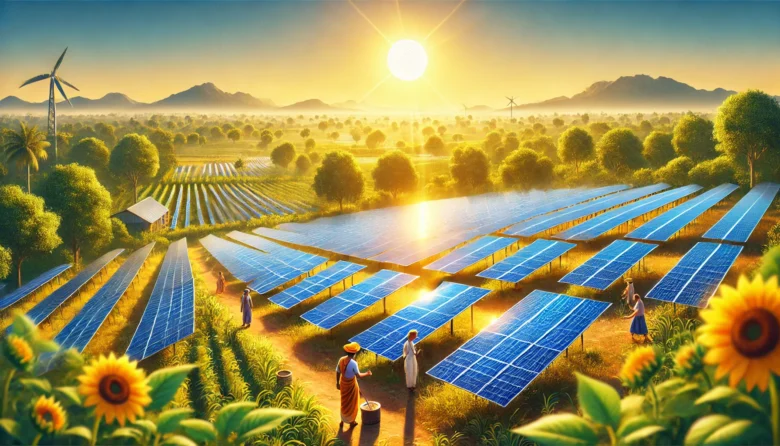India, with its large population and swiftly expanding economy, is at a crucial juncture. Shifting to renewable energy is not only an environmental necessity but also an economic advantage. In this blog, we will delve into the economics of the renewable energy transition, exploring its benefits, challenges, and the road ahead for India.
The Promise of Renewable Energy
Switching to renewable energy sources like solar, wind, and hydropower can transform India’s energy sector. Renewable energy sources are sustainable and increasingly affordable. The title “The Economics of Renewable Energy Transition” underscores the importance of understanding the financial implications of this shift.
Cost of Renewable Energy vs. Traditional Energy
A key point in favor of renewable energy is its decreasing cost. Over the past decade, the cost of solar panels and wind turbines has plummeted, making them competitive with traditional fossil fuels like coal and natural gas. In India, where coal has been the dominant energy source, this cost parity is a game-changer.
Solar Power
Solar energy is abundant in India, with most regions receiving ample sunlight throughout the year. The price of solar photovoltaic (PV) panels has dropped considerably, enabling India to become a leading solar energy producer globally. The government’s ambitious targets, such as achieving 175 GW (gigawatts) of renewable energy capacity by 2022, have spurred investments and innovations in this sector.

Wind Energy
Similarly, wind energy has seen substantial growth. India has vast coastal areas and open lands suitable for wind farms. The cost of wind turbines has also decreased, making wind power a viable option. States like Tamil Nadu and Gujarat are leading the way with large wind energy installations.
Economic Benefits
The renewable energy transition brings several economic benefits:
Job Creation: The renewable energy industry requires a significant amount of labor. From manufacturing to installation and maintenance, it creates jobs across various skill levels. The International Renewable Energy Agency (IRENA) predicts that India’s renewable energy sector could provide employment for more than a million people by 2030.
Energy Security: Relying on domestic renewable sources reduces dependence on imported fossil fuels. This not only enhances energy security but also stabilizes energy prices.
Health Benefits: Reducing air pollution from coal and oil reduces healthcare costs associated with respiratory and cardiovascular diseases.
Challenges in Transition
While the benefits are clear, the transition is not without challenges.
Infrastructure
India’s energy infrastructure needs a significant overhaul to integrate renewable energy. The grid must be modernized to handle the intermittent nature of solar and wind power. Investing in smart grids and energy storage solutions is essential.
Financing
The upfront investment needed for renewable energy projects can be high. Although costs are declining, securing financing remains a challenge, especially for smaller developers. Government incentives and private sector participation are vital to overcome this hurdle.
Policy and Regulation
Consistent and supportive government policies are essential. The Indian government has introduced various schemes and subsidies, but policy certainty and long-term planning are needed to attract sustained investment.
Case Study: Gujarat’s Solar Success
Gujarat has emerged as a leader in solar energy. The state’s proactive policies and investor-friendly environment have attracted significant investments. The Charanka Solar Park, one of the largest in Asia, is a testament to Gujarat’s commitment to renewable energy. The park has not only boosted the local economy but also set an example for other states to follow.
The Role of Technology
Technological innovations are vital for the transition to renewable energy. Innovations in solar panel efficiency, wind turbine design, and energy storage are making renewable energy more reliable and affordable.
Energy Storage
A major challenge for renewable energy is its variability. Energy storage solutions, like batteries, are crucial for maintaining a consistent power supply. Advances in battery technology, particularly lithium-ion and emerging alternatives, are critical to this effort.
Smart Grids
Smart grids enable better management of energy flow, balancing supply and demand in real time. They are essential for integrating renewable energy into the national grid and improving energy efficiency.
Government Initiatives
The Indian government has introduced multiple initiatives to support renewable energy. For instance, the National Solar Mission aims to position India as a global leader in solar power. Subsidies, tax incentives, and support for research and development are part of the government’s strategy to drive the renewable energy transition.
Public-Private Partnerships
Collaboration between the public and private sectors is key to accelerating the transition. Companies like Tata Power (a leading energy company in India) and Adani Green Energy (a subsidiary of the Adani Group focusing on renewable energy) are investing heavily in renewable projects. These collaborations utilize the strengths of both the public and private sectors to foster innovation and growth.
Conclusion
The economics of renewable energy transition in India is compelling. With the right policies, investments, and technological advancements, India can achieve its renewable energy targets while reaping significant economic benefits. The journey may be challenging, but the rewards are immense—a cleaner environment, a robust economy, and a sustainable future.
Author’s Note
Thank you for reading this blog. As an advocate for sustainable development, I believe the transition to renewable energy is essential for India’s future. Your feedback and thoughts are always welcome. Let’s work together towards a greener India!
G.C., Ecosociosphere contributor.




